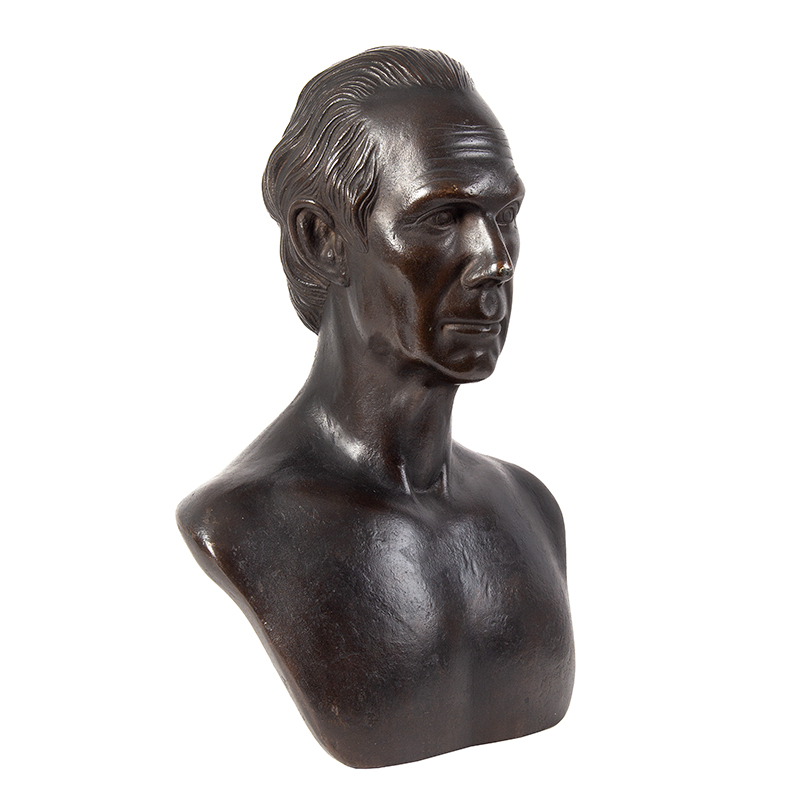


Attributed to Ferdinand Friedrich August Pettrich (German/American, 1798 – 1872), Washington, D.C.

Artist: The artist, born in Dresden, Germany, received early training from his father, Franz Pettrich (1770 – 1844), sculptor to the Saxon court and professor of sculpture at the Dresden Academy where the younger Pettrich studied from 1817 until 1819. With the encouragement and connections of his father, he perfected his skills in Rome under Bertel Thorwaldsen, the Danish-born neoclassical sculptor. Except for a brief stay in Florence in 1823 and Athens in 1833, Pettrich maintained his studio in Rome until 1835 when he decided to go to America.
The artists work was highly regarded in Europe, yet Pettrich assumed even greater opportunities awaited him in the new Republic, so at the age of thirty-seven he and his wife set sail for the United States. They settled briefly in Philadelphia, then in Washington, D.C., where Pettrich executed the likenesses of famous Americans such as Henry Clay, Martin Van Buren, John Tyler and Andrew Jackson. Pettrich’s years in Washington were disappointing. He had hoped to be included in the fraternity of artists winning government commissions, but his efforts were largely unsuccessful. In 1842 he survived a murder attempt while working in his Washington studio. He left for Brazil shortly thereafter, where he soon became the court sculptor to Emperor Dom Pedro II.
In 1858, when he was almost sixty years old, Pettrich returned to Rome. He was rewarded with the commission for the monumental tomb of Cardinal Bartholomew Pacca, who died in 1844, and created several allegorical figures, bas-reliefs, and portrait busts. One of his last works was a bust of the father of neoclassicism, Johann Joachim Winckelmann (1717 – 1768). He died in Rome in 1872
In a June 1838 letter to Washington socialite Margaret Bayard Smith (1778 – 1884), Clay expresses his satisfaction with an earlier portrait bust by Pettrich:
I share with you in all your sympathies with Mr, Pettrich, and your wishes that I should sit again to him shall have the most friendly consideration. If his were the single application, I should have no difficulty, but I have already sat to two artists, and I have been obliged to refuse many others.
The bust which has been already taken of me by Mr. P. has been recently very much praised for its fidelity. I wished to see it again and will take some early opportunity to do so. If it would answer a further sitting would be unnecessary, and I should be able to economise [sic] my time at a period when I very much need it all. If it be condemned I will try and sit to him again at this or the next Session.
The likeness is now among the collections of the Smithsonian. It seems probable Clay did indeed find time for a second sitting with Pettrich, a commission that may have ultimately produced the design for the iron bust herein cast four years later in 1842.
A second virtually identical iron bust of Henry Clay sheds further light on Pettrich’s techniques and his modeling of the southern statesman that was auctioned by Cates Antiques of Knoxville, Tennessee, in January 2016. The similarities between the two busts in craftsmanship, proportion and deft rendition of Clay’s facial features are remarkable – from the artist’s treatment of Clay’s wrinkled brow and wide forehead tom the subtle details of the politician’s hair. Beyond the physical similarities, plaster fills the internal voids of both busts.
An Important Note: Crucially, the Case Antiques bust retains a signatory plaque attached to the reverse at the nape of Clay’s neck , which states “HENRY CLAY / MADE BY / FERDINAND PETTRICH / 1842” The heavily oxidized surface of the label suggests it is likely original to the bust’s completion, and may represent a label Pettrich himself applied. Unfortunately, this important detail no longer survives on the bust herein, though it undoubtedly once exhibited a similar feature.
Several similar characteristics seen in the pair [Subject example offered herein and the Case Antiques example] described above suggest Pettrich also created a striking bust of Clay’s contemporary, U.S. Senator John C. Calhoun (1782-1850) of South Carolina. Presently exhibited in the politician’s home “Fort Hill” preserved as a historic house museum by Clemson University, the iron bust reveals similar casting techniques to those observed on the Clay examples. Like Clay, Calhoun stares confidently towards the viewer. Deeply set eyes beneath a heavy brow and gaunt cheeks define his passionate persona. On the reverse, a cylindrical socle – very similar in shape to that used on the Clay examples – supports Clay’s visage.
Item Date: Circa 1842
Measurement: Height: 22.25"; Width: 14.5: Depth: 9.5"
Material: Cast iron with a patinated bronze finish
Item Condition: The bust remains in overall very good condition. The sculpture shows even wear throughout the original bronze finish commensurate with its age…and presents some of the original luster. Minor visible loss to finish of the top of sitter’s nose, else fine.
SOLD
SKU 1121-115
For More Information, Please Contact David Hillier at 978-597-8084 or email drh@aaawt.com.
Please click on images to expand.